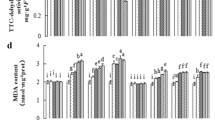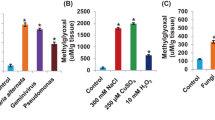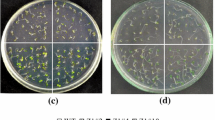Abstract
The aminoglycoside antibiotic hygromycin B (Hyg) inhibits prokaryotic, chloroplast and mitochondrial protein synthesis. Because of the toxic effect of Hyg on plant cells, the HPT gene, encoding hygromycin phosphotransferase, has become one of the most widely used selectable markers in plant transformation. Yet the mechanism behind Hyg-induced cell lethality in plants is not clearly understood. In this study, we aimed to decipher this mechanism. With Hyg treatment, rice calli exhibited cell death, and rice seedlings showed severe growth defects, leaf chlorosis and leaf shrinkage. Rice seedlings also exhibited severe lipid peroxidation and protein carbonylation, for oxidative stress damage at the cellular level. The production of reactive oxygen species such as O ·−2 , H2O2 and OH· was greatly induced in rice seedlings under Hyg stress, and pre-treatment with ascorbate increased resistance to Hyg-induced toxicity indicating the existence of oxidative stress. Overexpression of mitochondrial Alternative oxidase1a gene without HPT selection marker in rice enhanced tolerance to Hyg and attenuated the degradation of protein content, whereas the rice plastidial glutathione reductase 3 mutant showed increased sensitivity to Hyg. These results demonstrate that Hyg-induced cell lethality in rice is not only due to the inhibition of protein synthesis but also mediated by oxidative stress.







Similar content being viewed by others
References
Aono M, Saji H, Fujiyama K, Sugita M, Kondo N, Tanaka K (1995) Decrease in activity of glutathione reductase enhances paraquat sensitivity in transgenic Nicotiana tabacum. Plant Physiol 107:645–648
Apel K, Hirt H (2004) Reactive oxygen species: metabolism, oxidative stress, and signal transduction. Annu Rev Plant Biol 55:373–399
Bakker EP (1992) Aminoglycoside and aminocyclitol antibiotics: hygromycin B is an atypical bactericidal compound that exerts effects on cells of Escherichia coli characteristics for bacteriostatic aminocyclitols. J Gen Microbiol 138:563–569
Beauchamp CO, Fridovich I (1971) Superoxide dismutase. Improved assays and an assay applicable to acrylamide gel. Anal Biochem 44:276–287
Blochinger K, Diggelmann H (1984) Hygromycin B phosphotransferase as a selectable marker for DNA transfer experiments with higher eukaryotic cells. Mol Cell Biol 4:2929–2931
Bradford MM (1976) A rapid and sensitive method for the quantitation of microgram quantities of protein utilizing the principle of protein-dye binding. Anal Biochem 72:248–254
Cabañas MJ, Vázquez D, Modolell J (1978) Dual interference of hygromycin B with ribosomal translocation and with aminoacyl-tRNA recognition. Eur J Biochem 87:21–27
Caplan A, Dekeyser R, Van Montagu M (1992) Selectable markers for rice transformation. Methods Enzymol 216:426–441
Chen YP, Xing LP, Wu GJ, Wang HZ, Wang XE, Cao AZ, Chen PD (2007) Plastidial glutathione reductase from Haynaldia villosa is an enhancer of powdery mildew resistance in wheat (Triticum aestivum). Plant Cell Physiol 48:1702–1712
Christensen AH, Quail PH (1996) Ubiquitin promoter-based vectors for high-level expression of selectable and/or screenable marker genes in monocotyledonous plants. Transgenic Res 5:213–218
Davies J, Gorini L, Davis BD (1965) Misreading of RNA codewords induced by aminoglycoside antibiotics. Mol Pharmacol 1:93–106
Davis BD (1987) Mechanism of bactericidal action of aminoglycosides. Microbiol Rev 51:341–350
Dekeyser R, Claes B, Marichal M, Van Montagu M, Caplan A (1989) Evaluation of selectable markers for rice transformation. Plant Physiol 90:217–223
Ding S, Lu Q, Zhang Y, Yang Z, Wen X, Zhang L, Lu C (2009) Enhanced sensitivity to oxidative stress in transgenic tobacco plants with decreased glutathione reductase activity leads to a decrease in ascorbate pool and ascorbate redox state. Plant Mol Biol 69:577–592
Duan H, Ding X (2007) Effects of hygromycin on growth and development of Arabidopsis seedlings roots. Pak J Bot 39:2167–2173
Dwyer DJ, Kohanski MA, Hayete B, Collins JJ (2007) Gyrase inhibitors induce an oxidative damage cellular death pathway in Escherichia coli. Mol Syst Biol 3:91
Dwyer DJ, Belenky PA, Yang JH, MacDonald IC, Martell JD, Takahashi N, Chan CT, Lobritz MA, Braff D, Schwarz EG, Ye JD, Pati M, Vercruysse M, Ralifo PS, Allison KR, Khalil AS, Ting AY, Walker GC, Collins JJ (2014) Antibiotics induce redox-related physiological alterations as part of their lethality. Proc Natl Acad Sci USA 111:E2100–E2109
Elstner EF, Heupel A (1976) Inhibition of nitrite formation from hydroxylammonium-chloride: a simple assay for superoxide dismutase. Anal Biochem 70:616–620
Eustice DC, Wilhelm JM (1984) Mechanisms of action of aminoglycoside antibiotics in eukaryotic protein synthesis. Antimicrob Agents Chemother 26:53–60
Ezraty B, Vergnes A, Banzhaf M, Duverger Y, Huguenot A, Brochado AR, Su SY, Espinosa L, Loiseau L, Py B, Typas A, Barras F (2013) Fe–S cluster biosynthesis controls uptake of aminoglycosides in a ROS-less death pathway. Science 340:1583–1587
Foster JG, Hess JL (1980) Superoxide dismutase and glutathione reductase activities in cotton leaf tissue exposed to an atmosphere enriched in oxygen. Plant Physiol 66:482–487
Foti JJ, Devadoss B, Winkler JA, Collins J, Walker GC (2012) Oxidation of the guanine nucleotide pool underlies cell death by bactericidal antibiotics. Science 336:315–319
Gill SS, Tuteja N (2010) Reactive oxygen species and antioxidant machinery in abiotic stress tolerance in crop plants. Plant Physiol Biochem 48:909–930
Gonzalez A, Jimenez A, Vasquez D, Davies JE, Schindler D (1978) Studies on the mode of action of hygromycin B, an inhibitor of translocation in eukaryotes. Biochim Biophys Acta 521:459–469
Grant SS, Kaufmann BB, Chand NS, Haseley N, Hung DT (2012) Eradication of bacterial persisters with antibiotic-generated hydroxyl radicals. Proc Natl Acad Sci USA 109:12147–12152
Gritz L, Davies J (1983) Plasmid-encoded hygromycin B resistance: the sequence of hygromycin B phosphotransferase gene and its expression in Escherichia coli and Saccharomyces cerevisiae. Gene 25:179–188
Hagio T, Hirabayashi T, Machii H, Tomotsune H (1995) Production of fertile transgenic barley (Hordeum vulgare L.) plant using the hygromycin-resistance marker. Plant Cell Rep 14:329–334
Heath RL, Packer L (1968) Photoperoxidation in isolated chloroplasts I. Kinetics and stoichiometry of fatty acid peroxidation. Arch Biochem Biophys 125:189–198
Hiei Y, Ohta S, Komari T, Kumanshiro T (1994) Efficient transformation of rice (Oryza sativa L.) mediated by Agrobacterium and sequence analysis of the boundaries of T-DNA. Plant J 6:271–282
Hoefnagel MHN, Millar AH, Wiskich JT, Day DA (1995) Cytochrome and alternative respiratory pathways compete for electrons in the presence of pyruvate in soybean mitochondria. Arch Biochem Biophys 318:394–400
Hong CY, Cheng KJ, Tseng TH, Wang CS, Liu LF, Yu SM (2004) Production of two highly active bacterial phytases with broad pH optima in germinated transgenic rice seeds. Transgenic Res 13:29–33
Kalghatgi S, Spina CS, Costello JC, Liesa M, Morones-Ramirez JR, Slomovic S, Molina A, Shirihai OS, Collins JJ (2013) Bactericidal antibiotics induce mitochondrial dysfunction and oxidative damage in mammalian cells. Sci Transl Med 5:192ra85
Kato M, Shimizu S (1987) Chlorophyll metabolism in higher plant. VII. Chlorophyll degradation in senescing tobacco leaves; phenolic-dependent peroxidative degradation. Can J Bot 65:729–735
Keren I, Wu Y, Inocencio J, Mulcahy LR, Lewis K (2013) Killing by bactericidal antibiotics does not depend on reactive oxygen species. Science 339:1213–1216
Kohanski MA, Dwyer DJ, Hayete B, Lawrence CA, Collins JJ (2007) A common mechanism of cellular death induced by bactericidal antibiotics. Cell 130:797–810
Kohanski MA, Dwyer DJ, Wierzbowski J, Cottarel G, Collins JJ (2008) Mistranslation of membrane proteins and two-component system activation trigger antibiotic mediated cell death. Cell 135:679–690
Kohanski MA, DePristo MA, Collins JJ (2010) Sublethal antibiotic treatment leads to multidrug resistance via radical-induced mutagenesis. Mol Cell 37:311–320
Le Martret B, Poage M, Shiel K, Nugent GD, Dix PJ (2011) Tobacco chloroplast transformants expressing genes encoding dehydroascorbate reductase, glutathione reductase, and glutathione-S transferase, exhibit altered anti-oxidant metabolism and improved abiotic stress tolerance. Plant Biotechnol J 9:661–673
Levine RL, Garland D, Oliver CN, Amici A, Climent I, Lenz AG, Ahn BW, Shaltiel S, Stadtman ER (1990) Determination of carbonyl content in oxidatively modified proteins. Methods Enzymol 186:464–478
Liu Y, Imlay JA (2013) Cell death from antibiotics without the involvement of reactive oxygen species. Science 339:1210–1213
Liu Y, Liu X, Qu Y, Wang X, Li L, Zhao X (2012) Inhibitors of reactive oxygen species accumulation delay and/or reduce the lethality of several antistaphylococcal agents. Antimicrob Agents Chemother 56:6048–6050
Mann RL, Bromer WW (1958) The isolation of a second antibiotic from Streptomyces ygroscopicus. J Am Chem Soc 80:2714–2716
Mittler R, Vanderauwera S, Gollery M, Van Breusegem F (2004) Reactive oxygen gene network of plants. Trends Plant Sci 9:490–498
Møller IM (2001) Plant mitochondria and oxidative stress: electron transport, NADPH turnover, and metabolism of reactive oxygen species. Annu Rev Plant Physiol Plant Mol Biol 52:561–591
Nakano Y, Asada K (1981) Hydrogen peroxide is scavenged by ascorbate specific peroxidase in spinach chloroplasts. Plant Cell Physiol 22:867–880
Noctor G, Foyer CH (1998) Ascorbate and glutathione: keeping active oxygen under control. Annu Rev Plant Physiol Plant Mol Biol 49:249–279
Noctor G, Mhamdi A, Chaouch S, Han Y, Neukermans J, Marquez-Garcia B, Queval G, Foyer CH (2012) Glutathione in plants: an integrated overview. Plant Cell Environ 35:454–484
Orozco-Cárdenas ML, Ryan C (1999) Hydrogen peroxide is generated systemically in plant leaves by wounding and systemin via the octadecanoid pathway. Proc Natl Acad Sci USA 96:6553–6557
Purvis AC, Shewfelt RL (1993) Does the alternative pathway ameliorate chilling injury in sensitive plant tissues? Physiol Plant 88:712–718
Rizhsky L, Davletova S, Liang H, Mittler R (2004) The zinc finger protein Zat12 is required for cytosolic ascorbate peroxidase 1 expression during oxidative stress in Arabidopsis. J Biol Chem 279:11736–11743
Sandalio LM, Rodriguez-Serrano M, Romero-Puertas M, del Rio LA (2008) Imaging of reactive oxygen species and NO in vivo in plant tissues. Methods Enzymol 440:399–409
Scandalios JG (2002) The rise of ROS. Trends Biochem Sci 27:483–486
Setsukinai KI, Urano Y, Kakinuma K, Majima HJ, Nagano T (2003) Development of novel fluorescence probes that can reliably detect reactive oxygen species and distinguish specific species. J Biol Chem 278:3170–3175
Shu DF, Wang LY, Duan M, Deng YS, Meng QW (2011) Antisense-mediated depletion of tomato chloroplast glutathione reductase enhances susceptibility to chilling stress. Plant Physiol Biochem 49:1228–1237
Tsai YC, Hong CY, Liu LF, Kao CH (2004) Relative importance of Na+ and Cl− in NaCl-induced antioxidant systems in roots of rice seedlings. Physiol Plant 122:86–94
Van Den Elzen PJ, Townsend J, Lee KY, Bedbrook JR (1985) A chimeric hygromycin resistance gene as a selectable marker in plant cells. Plant Mol Biol 5:299–302
Waldron C, Murphy EB, Roberts JL, Gustafson GD, Armour SL, Malcom SK (1985) Resistance to hygromycin B: a new marker for plant transformation. Plant Mol Biol 5:103–108
Walters DA, Vetsch CS, Potts DE, Lundquist RC (1992) Transformation and inheritance of a hygromycin phosphotransferase gene in maize plants. Plant Mol Biol 18:189–200
Wang X, Zhao X (2009) Contribution of oxidative damage to antimicrobial lethality. Antimicrob Agents Chemother 53:1395–1402
Weisblum B, Davies J (1968) Antibiotic inhibitors of the bacterial ribosome. Bacteriol Rev 32:493–528
Wu TM, Lin WR, Kao YT, Hsu YT, Yeh CH, Hong CY, Kao CH (2013) Identification and characterization of a novel chloroplast/mitochondria co-localized glutathione reductase 3 involved in salt stress response in rice. Plant Mol Biol 83:379–390
Wu TM, Lin WR, Kao CH, Hong CY (2015) Gene knockout of glutathione reductase 3 results in increased sensitivity to salt stress in rice. Plant Mol Biol 87:555–564
Zidenga T, Leyva-Guerrero E, Moon H, Siritunga D, Sayre R (2012) Extending cassava root shelf life via reduction of reactive oxygen species production. Plant Physiol 159:1396–1407
Acknowledgments
This work was partly supported by research grant NSC 101-2313-B-002-008-MY3 from the Ministry of Science and Technology (MOST) of the Republic of China to C.Y. Hong. T.M. Wu was supported by a postdoctoral fellowship (NSC 103-2811-B-002-142) from the MOST of the Republic of China. N.N.P. Chandrika was supported by National Taiwan University Postdoctoral Research Fellowship.
Author information
Authors and Affiliations
Corresponding author
Additional information
Hui-Min Oung, Ke-Chun Lin, Tsung-Meng Wu, Nulu Naga Prafulla Chandrika have contributed equally to this work.
Electronic supplementary material
Below is the link to the electronic supplementary material.
Rights and permissions
About this article
Cite this article
Oung, HM., Lin, KC., Wu, TM. et al. Hygromycin B-induced cell death is partly mediated by reactive oxygen species in rice (Oryza sativa L.). Plant Mol Biol 89, 577–588 (2015). https://doi.org/10.1007/s11103-015-0380-4
Received:
Accepted:
Published:
Issue Date:
DOI: https://doi.org/10.1007/s11103-015-0380-4




